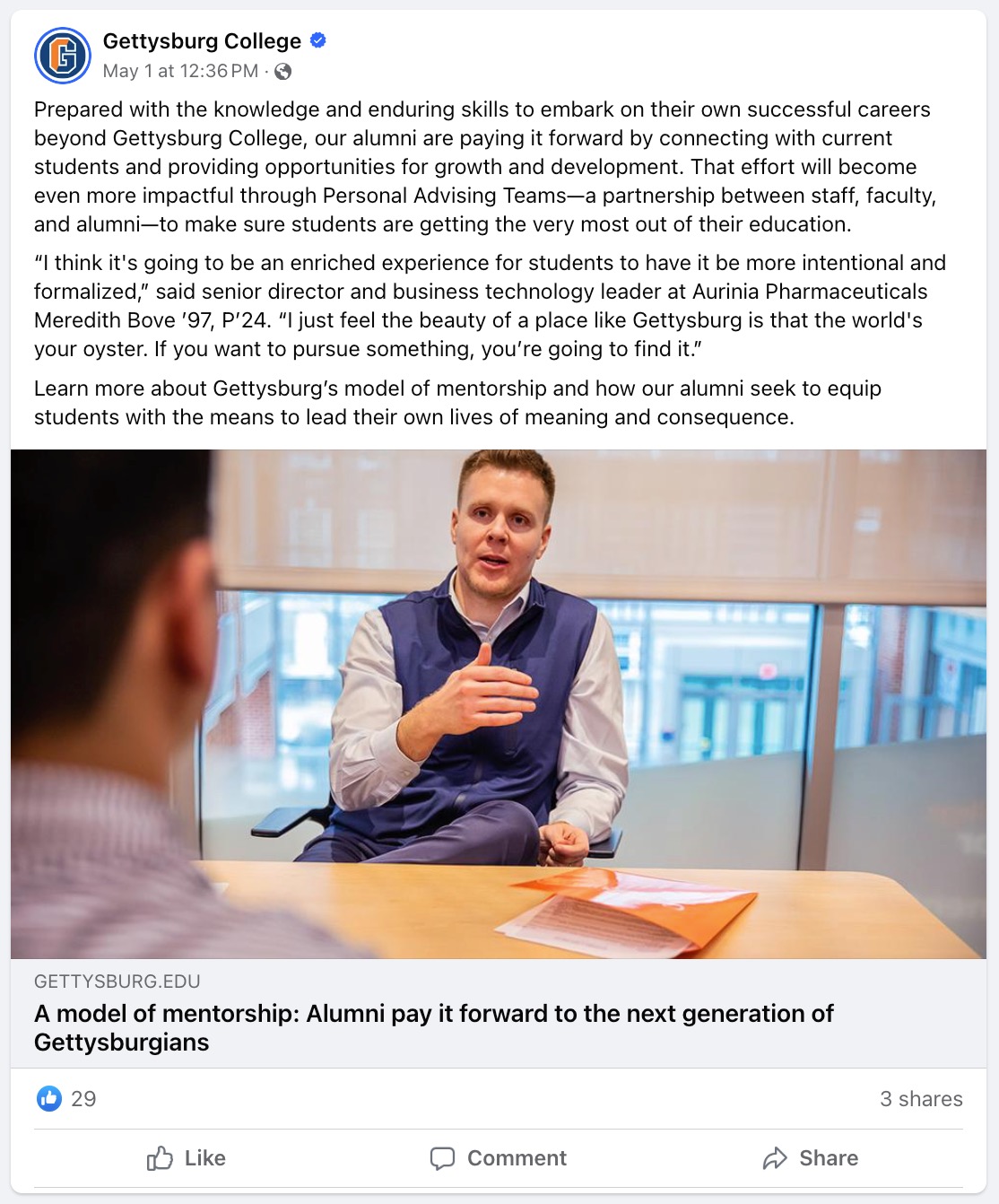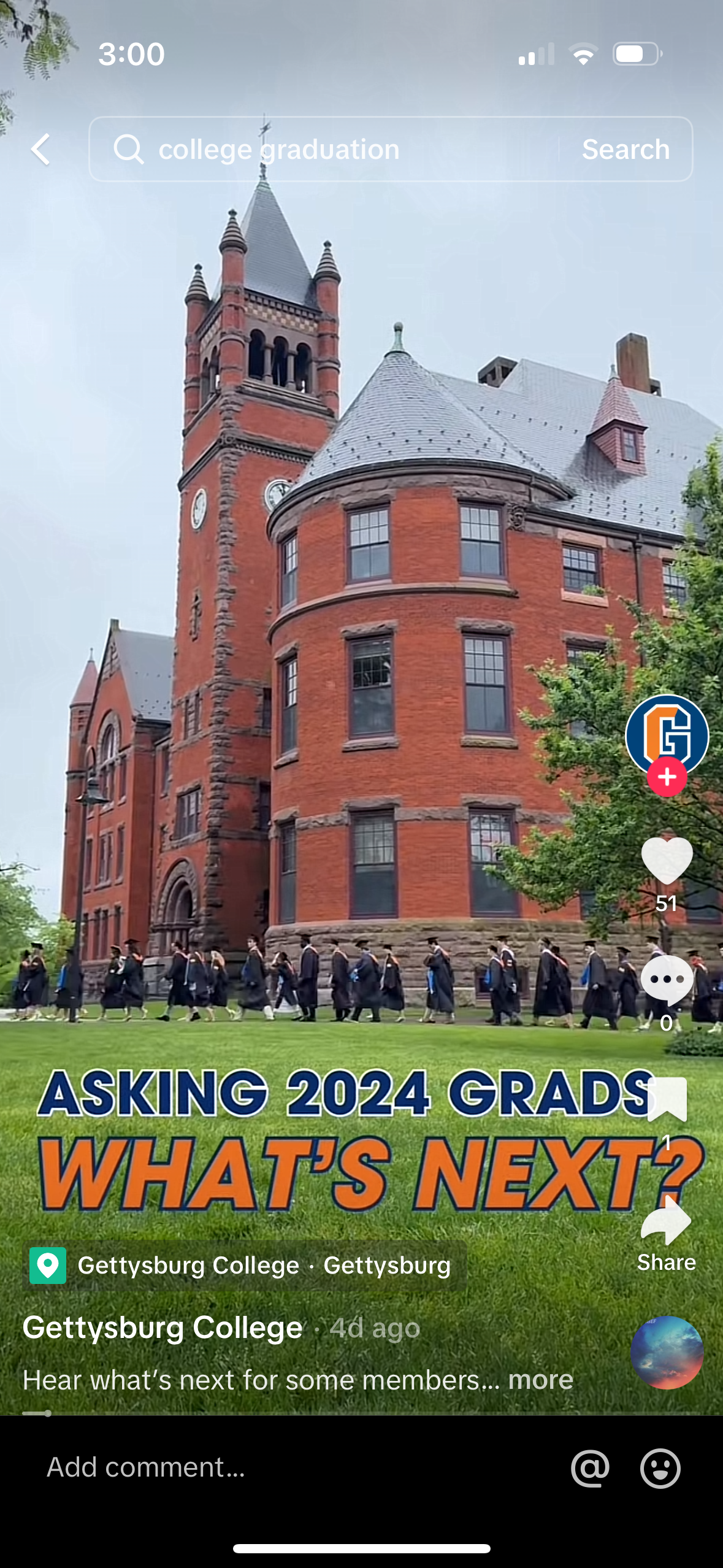An effective higher education social media strategy has to appeal to various audiences: current students, prospective students, alumni, staff, donors, fans, families and more. Each of these communities is unique, yet they all contribute to one shared college experience.
Addressing the needs and interests of multiple audiences calls for a commitment to data, collaboration and tailored messaging. Thankfully, each of these commitments supports the others. At least, that’s what Gettysburg College’s social team found after testing and learning.
Kailey White, assistant director of Social Media & Digital Strategy, and Staci Grimes, director of digital marketing are the driving force behind Gettysburg College’s social media strategy. Together, they’ve transformed digital spaces into online communities where key audience segments can deepen their engagement and advocacy with the college.
We spoke with Grimes and White to get the inside scoop on what it takes to develop a high-impact social media strategy for higher education institutions. Keep reading for their top tips, plus a behind-the-scenes look at their student intern program.
5 higher education social media tips from Gettysburg college
Marketing teams in universities and colleges manage various elements of their strategy, including department and program goals, audience needs and an overarching marketing plan. The following tips will help you balance these factors to create a cohesive, value-driven higher education social media strategy.
1. Create network-specific social media strategies
Gettysburg College’s largest audience is their current student population. It’s a key audience, but if they only created social content with traditional college students in mind, they’d miss the opportunity to engage other important groups, like parents and alumni.
“Understanding audiences and their preferences allows us to deliver more personalized experiences across channels,” says White. “For example, TikTok attracts a younger demographic, which requires a different content strategy than Facebook, where parents and families are our key audience.”

Sprout’s network-specific social media reporting options help White maintain an updated understanding of each profile’s unique audience. “Our strategy really acknowledges the different needs of our varying stakeholders, and we attribute that audience insight to Sprout.”
2. Connect marketing goals to university vision
If you want to create an effective higher education social media strategy, it’s not enough to seek engagement for engagement’s sake. Plans should align to your college’s goals for the future.
The Gettysburg College social team supports the institution’s strategic vision by enhancing its reputation and expanding its reach, while fostering an environment that strengthens recruitment and philanthropy.
“Our office uses an integrated marketing plan every year, and we map that directly to the College’s strategic direction,” explains Grimes. “We’ve identified the key metrics that allow us to understand whether or not our work is being impactful. That’s how we ensure that the work that we’re doing is advancing the vision for the institution.”
3. Share social media performance data proactively
Grimes and White show up to every planning meeting with relevant social insights, no matter who it’s with. This practice supports more collaborative work with several different organizations on campus, increasing the overall effectiveness of their strategy.
“We gather specific data so we can be as strategic as possible when consulting with different departments and programs,” says Grimes. “Our focus on performance and audience insights influence the cadence and delivery of messaging across the institution.”
White shares monthly reports with the Gettysburg content team so they can incorporate social insights into upcoming work. Grimes provides an analysis of social KPIs for reports that their Chief Communications & Marketing Officer, Jamie Yates, delivers to the school’s board of trustees several times a year to showcase the impact of their strategy. These reports may have different goals and audiences, but one source of truth informs them: Sprout Social.
“One of the things that I really appreciate about Sprout is the fact that all of our prominent brand accounts are attached to our Sprout dashboard,” shares Grimes. “It aggregates insights, allowing us to look at everything through the same lens.”

4. Work with campus partners
As the college’s social media presence grows and evolves, more programs are interested in getting involved. “We’ve definitely seen an influx of our campus partners joining social media spaces,” says White. “Our library, our dining services department, different academic programs—they’re all very involved, and they look to us to find out what they could be doing better.”
Grimes and White collaborate to support these requests by educating campus partners on how to navigate social media. They’ve created and shared presentations on representing the Gettysburg brand on social, launching a strategic social media presence and increasing student engagement.
These efforts create new opportunities to showcase the value of social media with strategic partners. As a result, the college continues to strengthen its online presence and foster a more connected campus community.
5. Use social listening to stay ahead of the conversation
According to Grimes, social listening is crucial for keeping the Gettysburg social media strategy audience-centric. “We use listening tools to evaluate the timing of different campaigns, assess the positive mentions of the college in digital spaces and measure our work against industry benchmarks.”
It also plays a key role in crisis management. When an issue—whether it be local, national or global—is unfolding, the Gettysburg team uses Listening to determine whether they should pause scheduled posts or develop messaging around the issue. The tool provides an overview of the conversation at large, along with valuable sentiment analysis data to provide a clearer understanding of audience opinions.

“Sometimes, an issue will feel very prominent to us because we’re in the comments and reading conversations. Then, we’ll look at Listening data and see that the conversation’s impact is pretty limited. It helps us understand from a really realistic perspective what truly is happening and whether or not we need to either take action or resume normal business.”
– Staci Grimes, Director of Digital Marketing, Gettysburg College
How Gettysburg College manages their student intern program with Sprout Social
The tips outlined above will help refine your strategy, but there’s nothing to refine without content. At Gettysburg, students aren’t only featured in social media posts—they’re also involved in planning and producing them.
The Gettysburg College marketing office hires a dozen or so interns every academic year. These roles mimic the responsibilities of the college’s professional staff, including copywriting, video production, photography and graphic design.
This isn’t your average internship. Students receive exclusive training and networking opportunities with previous intern cohorts. They also get the opportunity to collaborate on a professional-grade content production effort.
“The students use their talents to support one high profile event at the college every year.” explains White. “For the past two years, Gettysburg College and community partners hosted Ken Burns for the Gettysburg Film Festival, and our office interns have been highly involved in executing the coverage strategies for those events.”

White creates each student’s individual social media report using Sprout Social’s Tagging feature, which allows users to label pieces of content for more tailored reporting options.
“We create a specific Tag for every student intern,” says White. “That way, we can filter our reports with their name Tag to create their unique report. We can even drill down into their specific speciality. For example, if their focus is photography, we can filter the report by their name along with a content type Tag.”
These reports do more than just highlight their achievements—they help them stand out in a competitive job market. “The lead intern during the festival’s first year talked about the experience in a job interview, and the interviewer called our program director to share how impressed they were.” shares White. “She ended up landing the role, which was awesome to hear.”
The Gettysburg marketing internship program provides mutual benefits for both the social media team and the participating students. The students gain real-world work experience, while their contributions generate relevant, authentic content that drives higher engagement with key audiences.
Create a smarter higher education social media strategy with Sprout Social
When colleges and universities invest in their social media strategy, they do more than set up another communication channel. They foster a sense of community and build connections with students, alumni, fans and more.
Curious to see how other schools are using social media analytics tools to elevate their strategies? Find out how Texas A&M University earned 8.3 million content impressions in 6 months using Sprout.
